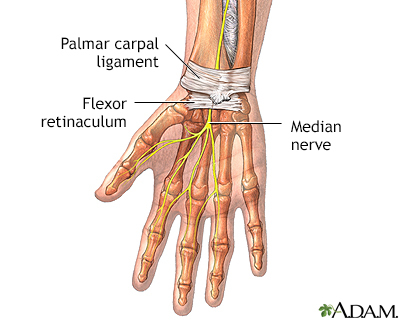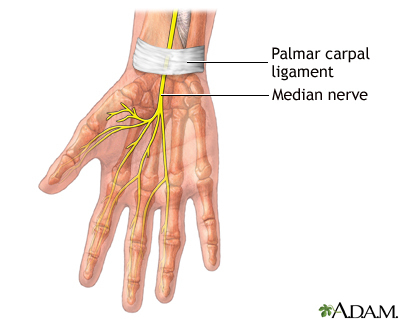Carpal Tunnel: What You Need to Know
There are times you don’t realize how important a function of your body is until it gets injured. You may be doing something you do every day and then pain and…

Update your location to show providers, locations, and services closest to you.
Carpal tunnel release is surgery to treat carpal tunnel syndrome. Carpal tunnel syndrome is pain and weakness in the hand that is caused by pressure on the median nerve in the wrist.
Median nerve decompression; Carpal tunnel decompression; Surgery - carpal tunnel
The median nerve and the tendons that flex (or curl) your fingers go through a passage called the carpal tunnel in your wrist. This tunnel is narrow, so any swelling can pinch the nerve and cause pain. A thick ligament (tissue) just under your skin (the carpal ligament) makes up the top of this tunnel. During the operation, the surgeon cuts through the carpal ligament to make more space for the nerve and tendons.
The surgery is done in the following way:
Sometimes this procedure is done using a tiny camera attached to a monitor. The surgeon inserts the camera into your wrist through a small surgical cut and views the monitor to see inside your wrist. This is called endoscopic surgery. The instrument used is called an endoscope.
People with symptoms of carpal tunnel syndrome usually try nonsurgical treatments first. These may include:
If none of these treatments help, some surgeons will test the electrical activity of the median nerve with an EMG (electromyogram). If the test shows that the problem is carpal tunnel syndrome, carpal tunnel release surgery may be recommended.
If the muscles in your hand and wrist are getting smaller because the nerve is being pinched, surgery will usually be done sooner.
Risks of this surgery are:
Before the surgery, you should:
On the day of surgery:
This surgery is done on an outpatient basis. You will not need to stay in the hospital.
After the surgery, your wrist will probably be in a splint or heavy bandage for about a week. Keep this on until your first doctor visit after surgery, and keep it clean and dry. After the splint or bandage is removed, you will begin motion exercises or a hand therapy program.
Carpal tunnel release decreases pain, nerve tingling, and numbness, and restores muscle strength. Most people are helped by this surgery.
The length of your recovery will depend on how long you had symptoms before surgery and how badly damaged your median nerve is. If you had symptoms for a long time, you may not be completely free of symptoms after you recover.





Amadio PC. Surgery management of compression neuropathies of the wrist. In: Skirven TM, Osterman AL, Fedorczyk JM, Amadio PC, Feldscher SB, Shin EK, eds. Rehabilitation of the Hand and Upper Extremity. 7th ed. Philadelphia, PA: Elsevier; 2021:chap 52.
Mackinnon SE, Novak CB. Compression neuropathies. In: Wolfe SW, Hotchkiss RN, Pederson WC, Kozin SH, Cohen MS, eds. Green's Operative Hand Surgery. 7th ed. Philadelphia, PA: Elsevier; 2017:chap 28.
Weller WJ, Calandruccio JH, Jobe MT. Compressive neuropathies of the hand, forearm, and elbow. In: Azar FM, Beaty JH, eds. Campbell's Operative Orthopaedics. 14th ed. Philadelphia, PA: Elsevier; 2021:chap 77.
Zhao M, Burke DT. Median neuropathy (carpal tunnel syndrome). In: Frontera WR, Silver JK, Rizzo TD Jr, eds. Essentials of Physical Medicine and Rehabilitation: Musculoskeletal Disorders, Pain, and Rehabilitation. 4th ed. Philadelphia, PA: Elsevier; 2019:chap 36.
There are times you don’t realize how important a function of your body is until it gets injured. You may be doing something you do every day and then pain and…
